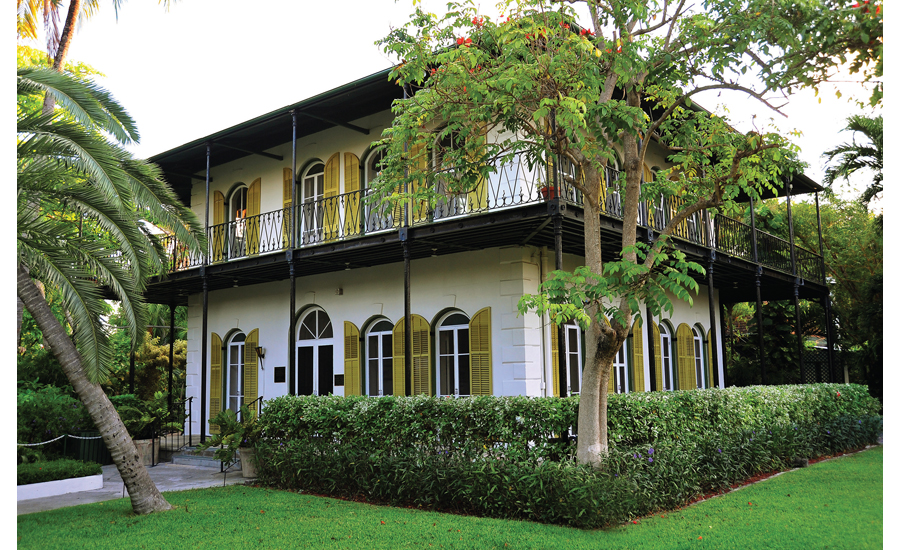Visitors to the Ernest Hemingway Home and Museum in Key West, Florida, enjoy stepping back in time to see how the prolific author lived during his 10 years in residence there in the 1930s. The two-story home was built in 1851 in the Spanish Colonial style, constructed of native limestone hewn from the grounds.
The home was in poor shape when Hemingway and his wife, Pauline, purchased it, but the couple could see beyond the rubble and ruin to appreciate the grand architecture and stateliness of the home. The massive restoration and remodeling they undertook in the early 1930s turned the home into the National Historical Landmark that thousands of tourists visit every year.
Curators have taken care over the years to preserve and maintain the original architecture and the Hemingway family’s furnishings. But one issue constantly plagued the home — the intense heat and humidity of the Florida Keys. The climate, especially in the summer, made it unbearably hot in the house. The discomfort was so pronounced from July through September that at least two visitors would faint during tours every week, said Dave Gonzales, longtime curator at the museum. Installing central air conditioning seemed out of the question, as it would require adding drop ceilings and soffits, which would disrupt the architectural integrity of the home. Window units would be equally destructive to the building’s character. Besides, the Key West historic architectural review committee would hardly be willing to approve such a project because of its negative impact on the building’s aesthetics, said Gonzales.
STRATEGY
Gonzales turned to colleagues at the nearby Harry S. Truman Little White House, another historic property-turned museum in Key West. He knew they had successfully installed central air conditioning without ripping out walls or lowering ceilings, and it was done with the blessing of the local architectural committee as well as the National Park Service. Gonzales learned that the museum had installed the small duct, high-velocity Unico System, known for its ability to remain mostly hidden from view. Unico’s tubular, flexible ducting can snake through crawl spaces and wall and ceiling cavities where traditional metal ducting could never fit. Hidden above ceilings or between floor joists, the Unico System sounded like the right solution for the Hemingway Home. Working with Unico engineers and a Miami HVAC contractor, Gonzales oversaw the installation process. He selected round room outlets made of red oak, in a stain that matched the home’s floors. He also came up with creative solutions, such as hiding a return air box in a wooden cabinet that he retrofitted with louvered doors for air flow. The installer carved through the floor inside the cabinet for the intake air ducting. Gonzales used the master bedroom closet on the second floor to house a small vertical air handler. The intake air box was installed in the bathroom closet. Normally it goes against building codes to pull intake air through a bathroom, but this bathroom had no running water, so inspectors approved it. “It took some explanations and convincing with inspectors, but we finally got the approval,” Gonzales said.
RESULTS
The Unico System has been an ideal solution for the Hemingway Home and Museum, said Gonzales.
“The system performs great, and our utility bill hasn’t gone up as much as we thought it would by adding
central air conditioning,” he said. The Unico System helps lower air conditioning bills by removing 30 percent more humidity from the air than a conventional central air system does. This allows homeowners
to set the thermostat a few degrees higher while still providing a comfortable temperature. Reduced humidity also aids in the preservation of the books, artifacts, and memorabilia displayed in the museum.
Gonzales added that the Unico System operates quietly, which is important because the museum conducts guided tours every 20 minutes. As many as 25 people participate in a tour. “The air conditioning doesn’t interfere at all — we can hardly hear it.” The best part, though, is that no one is fainting during tours anymore. Plus, the dozens of cats — descendants of Hemingway’s famed felines — roaming the house and grounds have a nice, comfortable place to relax. And if the temperature dips into the 40’s or 50’s on winter nights, the Unico System includes a heat pump to keep visitors — and cats — warm and cozy.
For more information, visit www.unicosystem.com.
Publication date: 7/24/2017
Want more HVAC industry news and information? Join The NEWS on Facebook, Twitter, and LinkedIn today!








